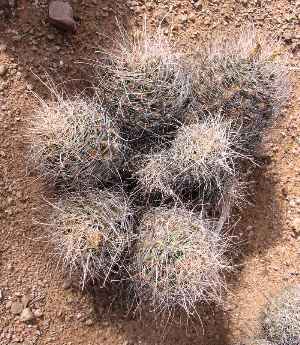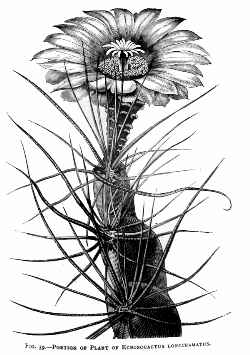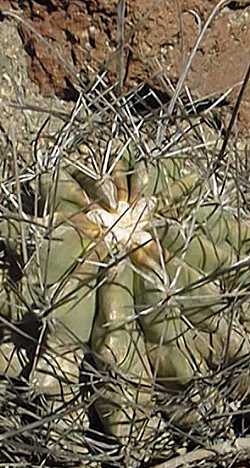Turks Head
Scientific Name: Ferocactus hamatacanthus ssp. hamatacanthus (Muehlpf.) Britton & Rose
Synonym: Bisnaga hamatacantha, Echinocactus flexispinus, Echinocactus hamatocanthus, Echinocactus longihamatus var. crassispinus , Echinocactus longihamatus, Ferocactus hamatacanthus var. crassispinus , Hamatocactus hamatacanthus, Hamatocactus longihamatus
Family: Cactaceae
USDA: 6-11
Frost Tolerance: The most cold resistant of the Ferocacti, hardy to below 0°F (-18°C)
Sun Exposure: Full sun
Origin: USA (southeastern New Mexico, southwestern Texas), northern Mexico
Growth Habits: Solitary, or sparsely clumping, dark green stem, 12 inches in diameter (30 cm), 2 feet tall (60 cm); 13 to 17 tuberculate ribs; areoles 0.4 to 1.2 inches apart (1-3 cm), young ones with yellow felt; 4 central spines, up to 6 inches long (15 cm); 8 to 12 radials, 2 to 3 inches long (5-7.5 cm)

The species name "hamatacanthus" comes from the Greek for "with hooked spines".

One rib and a flower, as Echinocactus longihamatus, picture from K. Schumann "Gesamtbeschreibung der Kakteen"
Blooming Habits:
Yellow flowers, greenish brown, outside, 2.8 inches long (7 cm). The green fruit, 0.8 to 2 inches long is fleshy and edible.
Desert-Tropicals is dedicated to provide gardening advice, gardening ideas, and information about flower of all kind for landscape and collections.We try to check carefully the identification of the plants on the illustrations as well as the other information from the page, but occasionally errors do occur. if you notice anything that needs to be changed please contact us.Thanks.
© 1998-2020 Philippe Faucon, All Rights Reserved.
